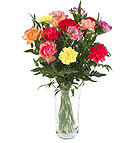- UK Information
- UK Florists
- Tips and advice
- Taking care of cut flowers to promote longevity
Taking care of cut flowers to promote longevity
Cut flowers can brighten up any room and add life and colour to your house. Follow our tips here and you should enjoy your flowers for as long as possible.

When you receive the flowers, gently lay the bouquet on the side and cut approximately 3cm off the bottom of the stems at a 45 degree angle using a sharp knife. Making a slanted cut provides stems with a bigger surface area for taking up more water, and also stops them from resting flat on the bottom of the vase, limiting their water intake. If you can cut the stems while holding them submerged they will absorb even more water.
Place your floral arrangement in a vase large enough to allow the stems to reach at least half-way down. Then fill it three quarters full with lukewarm water, adding the flower food supplied in accordance with the instructions on the sachet. It is better to put flowers in warm water, as lukewarm water contains less oxygen than cold water, and reduces the amount of air bubbles likely to form in the stem's network of tiny conductive vessels, blocking or limited water uptake. It is vital to ensure that your vase is completely clean, as residue from previous displays can harbour bacteria which will block the tiny tubules that carry water up the stems, causing your flowers to wilt. For the same reason, you should also remove any fronds and leaves which lie below the water level.
Flowers thrive in light, cool positions (18 - 22°C, or 65 - 72°F), away from direct sunlight, heating or cooling vents, radiators and other appliances that give off heat. Warm temperatures encourage flowers to respire at a higher rate and fade more quickly - so the cooler the room or location they're in, the longer they will last. However, draughty spots - such as in a hallway or near open doors - will not do your flowers any good either because they make petals dry out faster. Avoid placing bouquets or arrangements near ripening fruit, or leaving dying blooms in the display as these both release tiny amounts of ethylene gas which makes flowers age faster. Do not use metal containers as they neutralise the effects of flower food. Some cut flowers, such as tulips, continue to grow and will grow towards the light.
You should spray all fresh flowers with a gentle mist of water daily, and deadhead the floral arrangement regularly to remove any dying flowers. If the water in the vase looks cloudy or smells, throw it away and refill the vase with fresh, lukewarm water. Before replacing stems, trim them with a sharp knife or pair of scissors, cutting off approximately 3cm each time to remove any air bubbles that may have built up in the stems' sensitive network of water-transportation vessels. Continue to add flower food to the water as it contains a biocide which helps to keep bacteria at bay. (Additional sachets may be purchased at florists and nurseries).
Supplied in easy-to-use sachets, floral food contains three additives which work together to nourish flowers and deter bacteria:
- sugars to feed the blooms and encourage buds to form.
- biocides that kill the bacteria, yeasts and fungi.
- acidifiers to help water move up the stem more easily.
Bouquets and arrangements are normally delivered with sufficient flower food to last throughout their likely life span.
There are myths around about adding substances, such as lemonade, aspirin or bleach to the water? Lemonade or sugar help flowers to open, but also encourage bacteria to breed. Bleach is more likely to kill the flowers than help them. Other myths include coins and aspirin, which do nothing.
